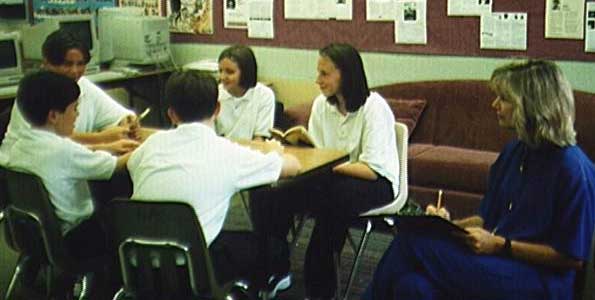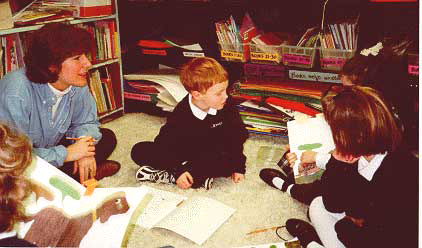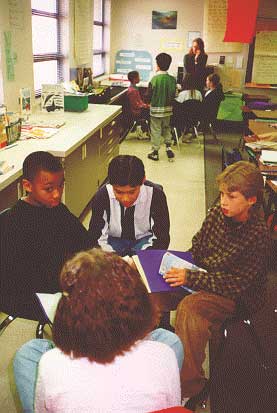| Literature Circles Resource Center | |
| home | structure | books | discussion | written response | themed units | extension projects | |
 |
|
Formats
for Discussion from Getting Started with Literature Circles Katherine L. Schlick Noe and Nancy J. Johnson ©1999 Christopher-Gordon Publishers, Inc. Reprinted by permission |
The format you select for discussions will depend on many things: your style, your students' ages and abilities, and needs that are specific to your classroom. You will certainly discover what best meets your needs as you and your students gain experience. Each of the formats described below has different benefits and challenges as the teacher assumes different roles:
One Group Meets
at a Time with the Teacher as Facilitator
One
Group Meets at a Time; Teacher Sits Near and Observes
When Janine King first started literature circles, one group met at a time and she sat near them and took anecdotal notes on their discussions. As shown in Figure 3.7, Janine sat close enough to hear her sixth graders' conversation, but far enough away so that the students did not rely on her to run the group. She kept this format all year, even though her students became independent enough for several groups to meet at once. She felt strongly that this format allowed her to observe how the groups worked together, as well as gave her a wealth of insight into students' responses to the books. "I would miss out on so much rich discussion if I wasn't there," she said.

Sixth grade teacher Janine
King at St. Joseph's School in Seattle, Washington Two or More Groups Meet at a Time; Teacher Roams as Observer and Guide Fourth grade teacher Lori Scobie at North City Elementary School, Shoreline, Washington In Lori Scobie's
fourth grade classroom, all groups meet at the same time for their
discussions (Figure 3.8) because this is what seems most manageable
to her. She can plan a set time each week when she knows that
all groups will discuss.
|
Literature Circles Resource Center © 2004 Katherine L. Schlick Noe College of Education Seattle University kschlnoe@seattleu.edu |

